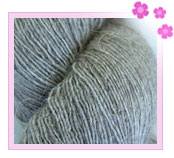Characteristics of Wool Fabric
 Wool grows in several natural colors such as black, brown, grey and the
most commonly available, white. Wool of any color takes dye easily and can
be felted. Wool straight from a sheep is highly water-resistant. It is said
to be "in the grease", the grease being lanolin, and can be worked
into yarn and knit into water-resistant mittens. This fabric retains heat
better than other fabrics when wet.
Wool grows in several natural colors such as black, brown, grey and the
most commonly available, white. Wool of any color takes dye easily and can
be felted. Wool straight from a sheep is highly water-resistant. It is said
to be "in the grease", the grease being lanolin, and can be worked
into yarn and knit into water-resistant mittens. This fabric retains heat
better than other fabrics when wet. Uses
In addition to clothing, wool has been used for carpeting, felting, and padding. Wool is used to absorb odors and noise in heavy machinery and stereo speakers. Ancient Greeks lined their helmets with felt and Roman legionnaires used breastplates made of wool felt.


